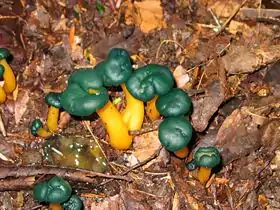Leotia
Leotia is a genus of cup fungi of the phylum Ascomycota. Leotia species are globally distributed, and are believed to be saprobic.[1] They are commonly known as jelly babies because of the gelatinous texture of their fruiting bodies.
| Leotia | |
|---|---|
 | |
| Leotia lubrica | |
| Scientific classification | |
| Kingdom: | |
| Phylum: | |
| Subphylum: | |
| Class: | |
| Order: | |
| Family: | |
| Genus: | Leotia Pers. (1794) |
| Type species | |
| Leotia lubrica (Scop.) Pers. (1797) | |
| Species | |
Biology
Leotia species are characterized by their capitate ascocarps. Within the class Leotiomycetes, Leotia species produce large fruiting bodies; their long-stalked apothecia bear a fertile layer of asci that covers the upper surface of a mushroom-like cap.
Leotia is closely related to Microglossum,[1] another genus characterized by capitate ascocarps. The species of Leotia have traditionally been defined largely by the fresh color of the ascocarps (tan in L. lubrica, olive-green in L. atrovirens, and green-headed with a yellow stalk in L. viscosa). However, a molecular phylogenetic study[2] revealed that color is a poor predictor of species affiliation, suggesting further study is needed to develop new, more predictive species concepts.
Gallery
References
- Wang Z, Binder M, Schoch CL, Johnston PR, Spatafora JW, Hibbett DS (November 2006). "Evolution of helotialean fungi (Leotiomycetes, Pezizomycotina): a nuclear rDNA phylogeny". Mol. Phylogenet. Evol. 41 (2): 295–312. doi:10.1016/j.ympev.2006.05.031. PMID 16837216.
- Zhong, Z; Pfister, DH. (2004). "Phylogenetic relationships among species of Leotia (Leotiales) based on ITS and RPB2 sequences". Mycological Progress. 3: 237–246. doi:10.1007/s11557-006-0094-8.
